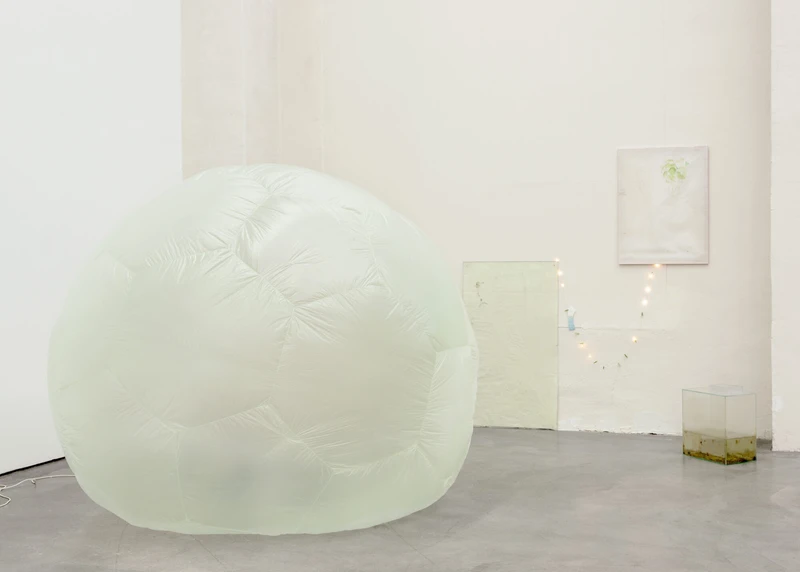Ian Kiaer


b. 1971, United Kingdom
Ian Kiaer’s (b.1971, London, UK) work is indebted to histories of painting, sculpture, architecture, literature and theory, but its central interest is repurposing: the waste, recovery and reconstitution of meaning. For over two decades, the artist has utilised found materials as a means to explore the latent legacies of lost ideas, the memories that physical objects preserve and the often-unseen relationships between material things. While the work might present as quiet, propositional and, in the case of Kiaer’s inflatable sculptures, temporary, it is the result of a long-standing inquiry into the ways in which artworks contain and convey both contingent and fragmentary information. As critic Jonathan Griffin writes: ‘Formally and philosophically, he tests the propensity of things to hold together, to prise apart or to float irredeemably away from one another. The conclusion he arrives at, more often than not, is the latter.’
The creative explication of reuse is central to Kiaer’s project. He has repurposed foam packaging, Korean bin-liners and sweet wrappers; fluorescent tubing and scratched Perspex screens lifted from bus shelters. When Kiaer disassembled Endnote, a vast inflatable work that was installed between Musée d’Art moderne de la Ville de Paris and Palais de Tokyo in 2020, he donated the light pink plastic to an architectural school to ensure that it was reprocessed once more. But while Kiaer is interested in the physical legacies that these timeworn materials introduce, his research into the art of reclamation has conceptual foundations. ‘The idea that one makes something from scratch is always false’, Kiaer says. ‘When making, you are involved in a conversation, you are taking up what someone else has already said and developing it. In this way, reuse can be a form of listening to what has been as well as what is.’ As such, Kiaer’s reanimations of ‘old’ things (and, in the case of the 2014 installation Tooth House, ceiling, prior works) are at once tributes to the historical discussions and gestures that facilitate his own practice and implicit critiques of the very notion of the ‘new’. ‘In one way’, says Kiaer, ‘all my work is a revision of ideas and things’.
This interest in return, reinterpretation and the incompleteness of influence accounts for Kiaer’s frequent employment of cardboard maquettes. For Kiaer, the architectural model can exist in three different states (representational, experimental, propositional) and, as such, can occupy three different tenses at once (past, present, future). In this way, it stands as an inherently in-between object: a means of ‘revisiting and rethinking and experimenting and then presenting, again, for the future’, the artist notes. Kiaer’s faith in the conceptual potential of the model has led him to reference and respond to such architectural luminaries as Peter de Bretteville, Aldo Rossi and, most notably, Frederick Kiesler, whose research into the ‘Tooth House’, an integrated residence designed in the late 1940s, lent its name to Kiaer’s 2014 exhibition at the Henry Moore Institute, Leeds. In revisiting and reappraising the provisional designs of these architects via his own maquettes, Kiaer encourages a broader reconsideration of the propositional potential of the art object itself, while also alluding to the manner in which all creative gestures are inseparable from one another. As art historian Fabrice Hergott writes in Kiaer’s 2020 monograph, Endnote, tooth: ‘He makes us experience the presence of death in existence, and the presence of life in what no longer exists.’
Considering the status of the architectural model in relation to Kiaer’s practice, Griffin writes: ‘It travels between an idea and the concretization of the idea, whether it has already taken place or is yet to come. It is physically light, transportable and schematic. It need not be finely crafted – in fact, speed is often a prerequisite of its construction.’ It could be said that movement, transience and lightness are at once the foundational materials of Kiaer’s work and its central theoretical concerns. Nowhere is this more evident than in the ongoing series of inflatables, many of which are brought into existence by an electric fan only to be deflated once more. (In the case of Endnote, limb, the monumental inflatable installed between the Musee d’Art Moderne and the Palais de Tokyo, the work was deflated after 30 minutes with a Stanley knife). By virtue of their abundant temporariness, the inflatables embody a duality that pervades so much of Kiaer’s work: these are aspirational forms that are destined to fail; gestures to the future that are bound to one day reside in the past. As academic Robert Harbison writes of Kiaer’s project, ‘the work is fundamentally about ways of living in a world that has definitively come to pieces’. But it is also about acknowledging that ‘in pieces’ is the only way to live: between past, present and future, interacting with the pieces of others that are doing the same.